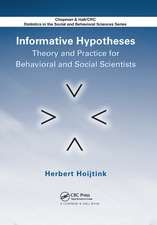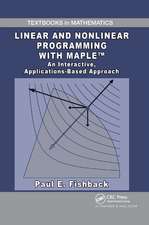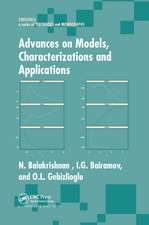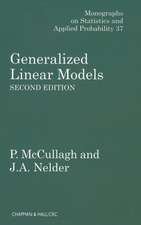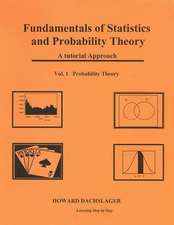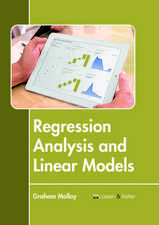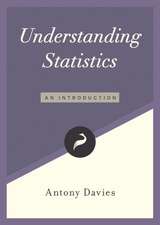Optimal Experimental Design with R
Autor Dieter Rasch, Jurgen Pilz, L.R. Verdooren, Albrecht Gebhardten Limba Engleză Paperback – 5 sep 2019
Providing a concise introduction to experimental design theory, Optimal Experimental Design with R:
- Introduces the philosophy of experimental design
Provides an easy process for constructing experimental designs and calculating necessary sample size using R programs
Teaches by example using a custom made R program package: OPDOE
Consisting of detailed, data-rich examples, this book introduces experimenters to the philosophy of experimentation, experimental design, and data collection. It gives researchers and statisticians guidance in the construction of optimum experimental designs using R programs, including sample size calculations, hypothesis testing, and confidence estimation. A final chapter of in-depth theoretical details is included for interested mathematical statisticians.
| Toate formatele și edițiile | Preț | Express |
|---|---|---|
| Paperback (1) | 489.26 lei 6-8 săpt. | |
| CRC Press – 5 sep 2019 | 489.26 lei 6-8 săpt. | |
| Hardback (1) | 898.49 lei 6-8 săpt. | |
| CRC Press – 18 mai 2011 | 898.49 lei 6-8 săpt. |
Preț: 489.26 lei
Preț vechi: 575.60 lei
-15% Nou
Puncte Express: 734
Preț estimativ în valută:
93.62€ • 98.01$ • 77.46£
93.62€ • 98.01$ • 77.46£
Carte tipărită la comandă
Livrare economică 05-19 aprilie
Preluare comenzi: 021 569.72.76
Specificații
ISBN-13: 9780367382766
ISBN-10: 0367382768
Pagini: 345
Dimensiuni: 156 x 234 x 27 mm
Greutate: 0.45 kg
Ediția:1
Editura: CRC Press
Colecția Chapman and Hall/CRC
ISBN-10: 0367382768
Pagini: 345
Dimensiuni: 156 x 234 x 27 mm
Greutate: 0.45 kg
Ediția:1
Editura: CRC Press
Colecția Chapman and Hall/CRC
Public țintă
Professional Practice & DevelopmentCuprins
Introduction. Determining the Minimal Size of an Experiment for Given Precision: Sample Size Determination in Completely Randomised Designs. Size of Experiments in Analysis of Variance Models. Sample Size Determination in Model II of Regression Analysis. Sequential Designs. Construction of Optimal Designs: Constructing Balanced Incomplete Block Designs. Constructing Fractional Factorial Designs. Exact Optimal Designs and Sample Sizes in Model I of Regression Analysis. Special Designs. Second Order Designs. Mixture Designs. Theoretical Background.
Notă biografică
Dieter Rasch: Currently Senior Consultant at the Centre of Experimental Design: University of Natural Resources and Life Sciences, Vienna, Dr. Rasch is an Elected Member of the International Statistical Institute (ISI), a Fellow of the IMS, and author/co-author of 46 books and more than 260 scientific papers.
From 1958- 1990, Dr. Rasch was Head of the Deparment (and Institute) of Biometry at the Research Centre Dummerstorf-Rostock, Germany. Afterwards, Dr. Rasch was professor of Mathematical Statistics at the University of Wageningen, The Netherlands from 1991 to 2000. Since 2000, he has served as a guest professor at the Math. Inst. of the University of Klagenfurt, the University Vienna, and at the Institute of Applied Statistics and Computing, University of Natural Resources and Life Sciences (2007 to 2010).
Albrecht Gebhardt: Assistant professor at the Institute of Statistics, University of Klagenfurt since 2004.
Jürgen Pilz: Professor and Chair of Applied Statistics at the University of Klagenfurt (UniKlu), Austria since 1994, and the head of the Department of Statistics at UniKlu since 2007. He has held many guest professorships, including at Purdue University, USA, Charles University, Prague,Czech Republic, the University of Augsburg, Germany, and the University of British Columbia, Vancouver, Canada. He is an Elected Member of the Int. Statist. Institute (ISI), a Fellow of the IMS, and author/co-author of six books and more than 100 scientific papers.
Rob Verdooren: A Consultant Statistician at Danone Research, Centre for Spceialised Nutrition, Wageningen, the Netherlands. He is retired Associate Professor in Experimental Design and Analysis at the Agricultural Uniiversity Wageningen, the Netherlands. Besides Experimental Design, his interests lies in Biostatistics and the design and analysis of breeding trials of Oil Palms in Indonesia.
From 1958- 1990, Dr. Rasch was Head of the Deparment (and Institute) of Biometry at the Research Centre Dummerstorf-Rostock, Germany. Afterwards, Dr. Rasch was professor of Mathematical Statistics at the University of Wageningen, The Netherlands from 1991 to 2000. Since 2000, he has served as a guest professor at the Math. Inst. of the University of Klagenfurt, the University Vienna, and at the Institute of Applied Statistics and Computing, University of Natural Resources and Life Sciences (2007 to 2010).
Albrecht Gebhardt: Assistant professor at the Institute of Statistics, University of Klagenfurt since 2004.
Jürgen Pilz: Professor and Chair of Applied Statistics at the University of Klagenfurt (UniKlu), Austria since 1994, and the head of the Department of Statistics at UniKlu since 2007. He has held many guest professorships, including at Purdue University, USA, Charles University, Prague,Czech Republic, the University of Augsburg, Germany, and the University of British Columbia, Vancouver, Canada. He is an Elected Member of the Int. Statist. Institute (ISI), a Fellow of the IMS, and author/co-author of six books and more than 100 scientific papers.
Rob Verdooren: A Consultant Statistician at Danone Research, Centre for Spceialised Nutrition, Wageningen, the Netherlands. He is retired Associate Professor in Experimental Design and Analysis at the Agricultural Uniiversity Wageningen, the Netherlands. Besides Experimental Design, his interests lies in Biostatistics and the design and analysis of breeding trials of Oil Palms in Indonesia.
Descriere
Optimal Experimental Design with R introduces experimenters to the philosophy of experimentation, and the need for good design and data collection for experiments. It gives experimenters and statisticians guidance on how to construct optimum experimental designs and calculate the sample size needed using R programs. The book contains many detailed real-world examples that show how the R programs should be used. The authors discuss variations of the regression model, including linear and nonlinear regression models. They also provide a final chapter of theoretical details for interested mathematical statisticians.



